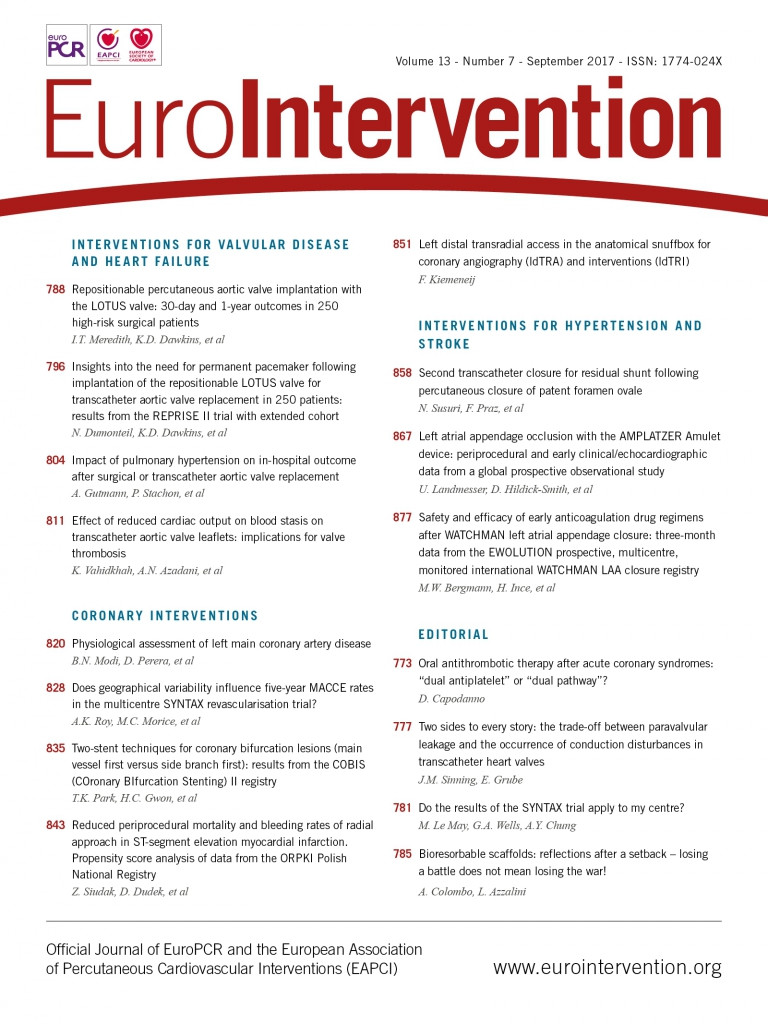
Recent evidence from the three-year follow-up of the ABSORB II trial1, the two-year data of the ABSORB III trial (Ellis SG et al, presented at the American College of Cardiology 2017 congress, Washington DC, USA), and the Amsterdam Investigator-initiateD Absorb strategy all-comers (AIDA) trial2, has suggested that the Absorb™ (Abbott Vascular, Santa Clara, CA, USA) bioresorbable scaffold (BRS) exhibits inferior performance as compared with the benchmark metallic everolimus-eluting stent (EES) in terms of late luminal loss, target vessel myocardial infarction, and scaffold thrombosis (ST). These facts prompted the manufacturer to halt the commercialisation of the device in Europe with effect from 31 May 2017. Absorb is now available for use only at sites where clinical registries are already in progress.
The jury is still out on the other three currently available BRS with a Conformité Européenne (CE) mark (DESolve® [Elixir Medical, Milpitas, CA, USA]; Magmaris [Biotronik, Berlin, Germany]; and Fantom® [REVA Medical, San Diego, CA, USA]), which however have clinical data involving a smaller overall sample, with selected lesions and patient populations. The bottom line is that the field of BRS-based revascularisation has witnessed an abrupt stop, prompting a thorough reflection on the future role of these devices in modern percutaneous coronary intervention (PCI).
In our opinion, a few points deserve special attention. The first and most important issue has been the “arrogance of ingenuity” (“naïve hybris”) to compare this “newborn” with a “giant” such as the metallic EES, a second-generation device that has outperformed even more recent drug-eluting stents (DES)3. Comparing a groundbreaking technology in its infancy with such a mature player has indeed harmed the BRS and compromised its clinical development.
The consideration that a critical improvement in BRS performance will stem from a decrease in strut thickness comes second. Currently, available devices feature struts that are significantly thicker (Absorb 156 µm, DESolve 150 µm, Magmaris 150 µm, Fantom 125 µm) than contemporary metallic DES (60-90 µm). This is associated with rheological disturbances, with areas of low endothelial shear stress in proximity to the struts, which has been linked to an increased risk of stent thrombosis (ST)4. A decrease in strut thickness will have three major effects: 1) increase in peri-strut endothelial shear stress with subsequent improved profile with regard to the risk of ST5; 2) decrease of “vessel footprinting” (the percentage of the vascular circumference occupied by struts at the level of the minimum lumen diameter, which shows a positive correlation with ST, particularly in small vessels6); and 3) improvement in crossing profile.
Third, a meticulous implantation technique is currently required to ensure durable results when implanting BRS. This includes aggressive lesion preparation, correct BRS sizing, and systematic post-dilatation. Additionally, the use of intravascular imaging is warranted (at least to confirm an optimal final result), particularly in complex lesions (overlapping scaffolds, calcified lesions, chronic total occlusions, etc.). When BRS implantation is performed according to the aforementioned principles, in our experience long-term clinical outcomes are acceptable and the rate of ST is low (1.2%) at two-year follow-up, despite high lesion complexity (75% type B2/C lesions) and long total scaffold length (53.2±32.5 mm)7. However, the implementation of such a meticulous technique significantly lengthens the procedure (by approximately 30 minutes, when compared to metallic DES), mostly due to repeated intravascular imaging runs8. Nevertheless, we should not dismiss the important concept, which applies to current DES as well, that easy implantation does not necessarily translate into superior or equivalent long-term outcomes.
Fourth, specific mechanisms leading to ST in BRS-treated patients (e.g., intraluminal scaffold dismantling9) and their interaction with dual antiplatelet therapy (DAPT) status10 provide the basis for the theoretical recommendation to prolong DAPT until full scaffold resorption. In fact, in one study the incidence of ST was higher after DAPT discontinuation, and no case of very late ST occurred in patients who continued DAPT for at least 18 months10. Therefore, we are starting to believe that DAPT should be extended beyond the usual duration (6-12 months), and until full BRS resorption is completed (e.g., 36 months with Absorb)11.
Fifth, additional concerns about the fragility of BRS platforms need to be taken into account. This translates into the risk of fracture when BRS are overdilated (e.g., >0.5 mm larger than the nominal diameter for Absorb) and when tackling bifurcation stenting with the need to perform balloon inflation towards the side branch.
Therefore, we think that, in order to promote a wider adoption of BRS-based PCI, new devices should be more forgiving in terms of technical requirements to achieve an optimal result. A higher radial force and thinner struts should be the landmarks of second-generation BRS.
Regarding future randomised clinical trials assessing BRS performance in comparison with contemporary metallic DES, we see the need for endpoint evaluation no earlier than five years, when full resorption has taken place.
The first chapter of the bioresorbable saga has just concluded, showing that the probable long-term benefits can only be accepted if there is no additional short-term price to pay (safety and complexity of the procedure, duration of DAPT, etc.).
Conflict of interest statement
L. Azzalini has received research support from ACIST Medical Systems and honoraria from Guerbet. A. Colombo has no conflicts of interest to declare.

